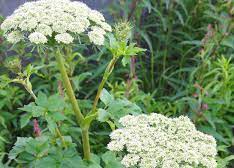
Return to Specific Plants Discussed in Oral History Interviews page
Angelica, also known as wild celery (ikuusuk in Iñupiaq), is a flowering plant with hollow stems that mostly grows in coastal parts of Alaska. Caution must be taken when harvesting wild celery as it looks similar to poisonous water hemlock or cow parsnip. Always be sure to accompany or consult an experienced harvester or refer to a book. Alaska Natives have used parts of angelica/wild celery as traditional medicine and as part of their traditional diet.
Listen to Vera Angasan, Sugpiaq (Alutiiq) from King Salmon, Alaska, talk about using angelica. Or read the transcript (ORAL HISTORY 98-22-05).
Listen to Vera Angasan, Sugpiaq (Alutiiq) from King Salmon, Alaska, talk about wild celery. Or read the transcript (ORAL HISTORY 98-22-05).
Listen to Ted Melgenak, Sugpiaq (Alutiiq) from King Salmon, Alaska, talk about wild celery. Or read the transcript (ORAL HISTORY 98-22-04).
Listen to Ted Angasan, Sugpiaq (Alutiiq) from South Naknek, Alaska, talk about wild celery. Or read the transcript (ORAL HISTORY 98-22-03).
Listen to Pauline Ramoth, Iñupiaq from Selawik, Alaska talk about harvesting and eating wild celery. Or read the transcript (ORAL HISTORY 2018-04-04).
Information about angelica at Western Arctic National Parklands: Cape Krusenstern National Monument, Kobuk Valley National Park, and Noatak National Preserve.

